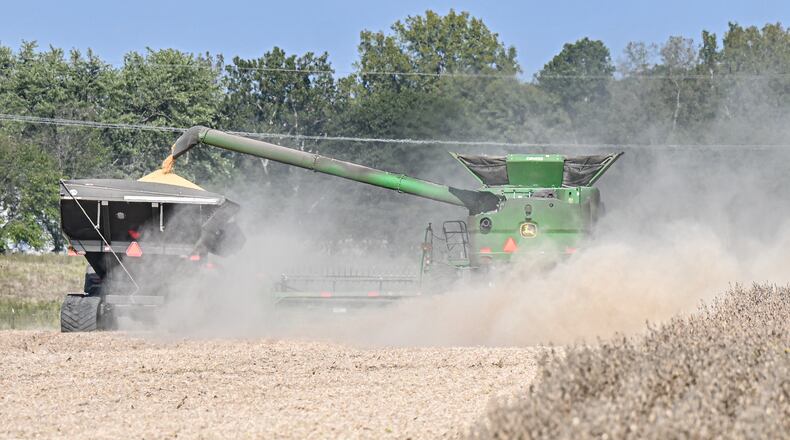The situation is especially serious as China continues sourcing soybeans from other countries, while the U.S. has yet to secure a new trade agreement to restore domestic purchases, according to Kirk Merritt, executive director of the Ohio Soybean Association and Ohio Soybean Council.
Merritt said that typically, by this point in the marketing year, which runs from September to August, China would have committed to billions of dollars in purchases. But instead, “today, we have no orders on the books from China” for the current crop, he said.
“They have relied exclusively on Brazil, and in recent days they also have placed orders with Argentina, which is unusual,” Merritt said. “So clearly, it’s important that we see a successful negotiation of a trade deal that brings China back into the market.”
Axios reported that Treasury Secretary Scott Bessent said on Thursday that the Trump administration would release details this week on “substantial support” for American farmers.
“You should expect some news on Tuesday on substantial support for our farmers, especially the soybean farmers — they have had President Trump’s back and we have their back,” Bessent said.
Credit: Nick Graham
Credit: Nick Graham
Administration officials have not yet indicated how the farmer payouts would be structured, or what the aggregate cost might be, according to Axios.
“The Soybean Farmers of our Country are being hurt because China is, for ‘negotiating’ reasons only, not buying,” Trump said in a Truth Social post on Wednesday. “We’ve made so much money on Tariffs, that we are going to take a small portion of that money, and help our Farmers.”
With no orders on the books and the harvest underway, the farm economy is already in “a very challenging situation,” Merritt said.
“Crop farmers in Ohio and across the country are already facing prices for their crops that are at multi-year lows and input costs have stayed high, so the revenue that farmers are receiving and expect to receive ... for the sale of their crop is low,” Merritt said.
He said the window is closing for farmers to be able to get the the solution that they need to be able to make ends meet this year, but he believes there still is time.
“‘The crop is not yet in the bin,’ as the farmers say, and if a deal with China could be negotiated and they would come back into the market for U.S. soybeans. There’s still time. That that still could happen, but it needs to happen,” Merritt said. “We need the administration to have a very high level of urgency in negotiating.”
For decades, China has been the largest buyer of U.S. soybeans, purchasing roughly 25 to 30% of the entire crop, Merritt said.
But when U.S. tariffs on Chinese exports spiked in April, China retaliated with its own tariffs and stopped buying soybeans from the United States.
That’s been evident in the amount of U.S. soybean bushels shipped to China.
In 2024, the U.S. shipped nearly 985 million bushels of soybeans to China, representing over 50% of total American soybean exports and generating $13.2 billion in revenue, according to the American Soybean Association. But in a dramatic shift between January and August this year, exports to China have plummeted in 2025, with only 218 million bushels delivered.
Profits for U.S. farmers have dwindled with China buying from other countries like Brazil and Argentina.
“They can go to South America and buy the soybeans and pay 30% less, which is a considerable percentage,” Farmer Dale Settlemyre, of Clinton County’s Clarksville, told media partner WCPO.
He said he is concerned that South American countries will continue to build their infrastructure and, in turn, China may keep buying from those countries.
Credit: Nick Graham
Credit: Nick Graham
“It’ll be cheaper for them because they can get to the west coast, and that’s a direct shot to China,” Settlemyre said.
He’s still selling his product to other countries, but his profits have taken a hit.
That’s partially because the price per bushel for soybeans has dropped several dollars from around $17 in 2022 to as low as $9.34 last month, Merritt said.
The price as of Friday was a little more than $10 a bushel.
Michael Brehm, a third-generation farmer for 44 years, tends 3,800 acres of crops in Darke County, with about two thirds of that devoted to soybeans and the remaining third to corn.
He said farmers lost about $2 a bushel once President Donald Trump, in his first term, imposed tariffs in 2018.
The U.S. Department of Agriculture estimates that U.S. soybean farmers experienced $9.4 billion in annualized losses during the 2018 trade war. which constitutes 71% of the $27 billion total loss in agricultural exports sustained by U.S. farmers during that time.
Brehm said he does not believe a deal with China can be worked out and believes the United States should move on from them as a trade partner for soybeans.
“We’ve been basing our market of soybeans on China for the last 10 years,” he said. “We just need to find another source for them.”
Gary Gerber of Butler County’s Wayne Twp. said the harvest soybeans at his farm is “well underway,” with the crop being harvested slightly early this year because of the dry weather of the last six weeks.
“Yields are average at best,” he told this news outlet. “We just needed about one more good rain there, about the middle of August, so that would have made a huge difference in yields, so yields are down, prices are down.
“These things run somewhat on supply and demand. We’re still waiting to see how this tariff thing works out.”
The soybean industry is the mainstay of 26,000 soybean farmers and tens of thousands more employed through related industries, Merritt said.
Having the price of soybeans drop so low due to a decrease in demand can take farmers below the cost of production “and therefore we make zero,” Brehm said.
“How many people would go to work for 10 (to) 12 hours a day, and then maybe get 10 cents at the end of the day?” the Darke County farmer said.
Merritt said efforts to diversify export markets are underway. Countries like Bangladesh, Egypt, Indonesia and Vietnam have shown increased interest in U.S. soybeans, but these relationships are still developing, he said.
“We have made a lot of progress in recent years in expanding and diversifying our export markets, but it took years to build the market we have with China,” he said. “You can’t overnight replace 25% to 30% of your entire crop with other export markets.”
Merritt said Taiwan’s recent multi-billion-dollar agricultural agreement, including a major soybean component, is a key source of optimism.
“They will continue to buy a lot from Ohio and from other soybean producing states,” he said. “That market is not large enough to make up for for the loss of sales to China, but that type of partnership and that type of relationship building certainly will lead to to more opportunities.”
China is the biggest buyer of U.S. soybeans, taking five times more than the next largest customer, the European Union, according to the Ohio Soybean Association. Losing China means finding five new, EU-sized markets, which is nearly impossible, the association said in a recent release.
Argentina recently reduced taxes on soybean exports, leading China to buy 35 shipments from them, according to OSA. Soon after, the United States announced $20 billion in aid to Argentina, upsetting American farmers.
OSA President and Williams County soybean farmer Rusty Goebel said that helps a competitor while U.S. farmers struggle with tariffs and lost sales to China.
“We need the administration to focus on what matters in the heartland — restoring the market that so many famers’ livelihoods depend upon," Goebel said in a statement.
About the Author



